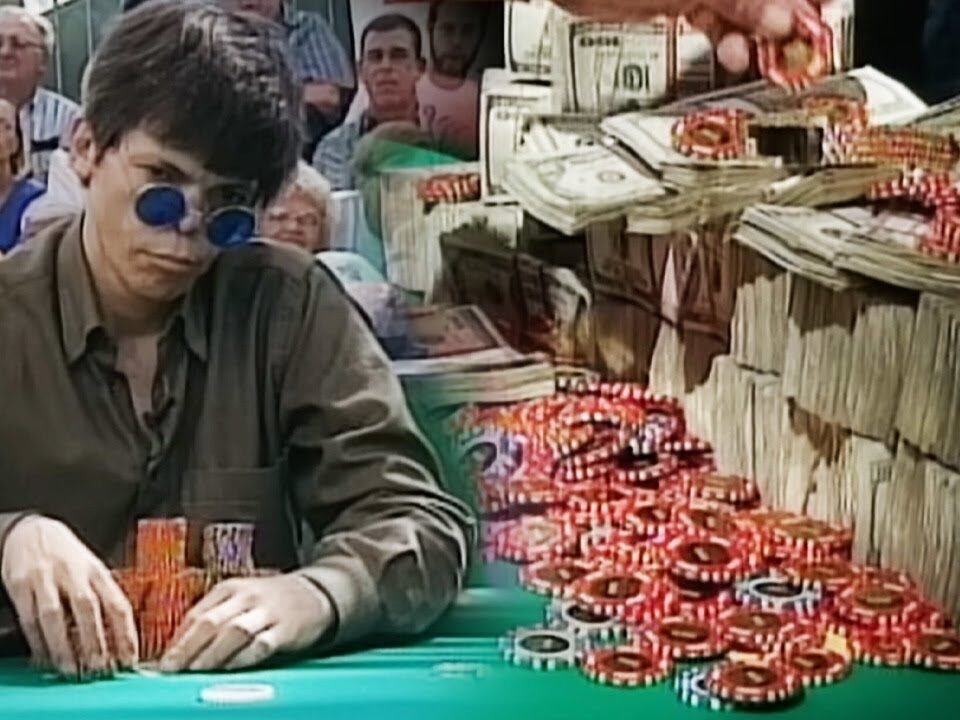How Poker’s Greatest Genius Stu Ungar Lost Everything

A Prodigy Born in the Shadows
Some legends are born in casinos, others are forged in smoke-filled backrooms. Stu Ungar—better known as “The Kid”—was both.
From the moment he picked up a deck of cards, it was clear he was different. With a photographic memory and an uncanny gift for numbers, Stuey was outplaying seasoned hustlers before he even finished high school.
By ten years old, he was already crushing gin rummy tournaments. By his late teens, he was feared across New York’s underground gambling scene. And when gin rummy began to fade, Ungar pivoted to poker—where his genius would shine brightest.
The Making of a Legend
In 1980, at just 27, Ungar shocked the poker world by winning the World Series of Poker Main Event. The man he toppled? None other than Doyle Brunson, the reigning back-to-back champion. One year later, Ungar returned to defend his title—and did it again.
He became the youngest two-time WSOP champion in history and cemented his reputation as a fearless, aggressive player who could read opponents like an open book.
He wasn’t just good—he was unstoppable. Ungar didn’t play cautious, conservative poker. He played to dominate, leaning on instincts and a mind that processed probabilities faster than any computer of the era.

Success With a Shadow
But genius often comes at a cost. Behind the trophies, the million-dollar pots, and the accolades, Ungar was already spiraling.
Introduced to cocaine in the early 1980s, he embraced it first as a way to stay awake, alert, and sharp through marathon sessions. Soon, though, it became more than a tool—it became a cage.
Cocaine ate at his health, his fortune, and his relationships. His once razor-sharp reads dulled. His bankroll—once millions deep—vanished as fast as it came in, blown on high-stakes gambling, reckless spending, and drugs.
He had cars he barely drove. He had no bank account, preferring to stash wads of cash in safe deposit boxes across Las Vegas hotels. He was living fast, reckless, and always on the edge.
The 1997 Miracle
By the mid-1990s, many assumed Ungar was finished. His gaunt frame, collapsing nose cartilage, and long absences from the felt told a story of decline. But then came the 1997 World Series of Poker Main Event.
Broke and broken, he turned to an old friend, Billy Baxter, who staked him the $10,000 buy-in. Against all odds, Ungar summoned the brilliance of his youth. He dismantled the field, outplayed legends, and won his third WSOP Main Event.
It was redemption—if only for a moment. In his victory speech, he dedicated the win to his daughter, Stephanie. For a brief time, the poker world dared to hope “The Kid” had one more comeback left.

The Demons Return
But hope can be fragile. The million-dollar prize didn’t last. Drugs consumed him again, dragging him back into debt, back into chaos. He skipped tournaments, vanished for weeks, and borrowed money to feed his habits.
Friends tried to help. Rehab stints were arranged. But Ungar couldn’t escape. His brilliance was chained to his addiction.
The Final Chapter
On November 22, 1998, Stu Ungar was found dead in a cheap Las Vegas motel room. The autopsy revealed heart disease brought on by years of cocaine abuse. He was only 45.
The man who had once been the sharpest mind in poker, who won over $30 million across his career, died nearly penniless—leaving behind not only a broken legacy but also a daughter who adored him.
The Legacy of “The Kid”
Stu Ungar’s story isn’t just about poker. It’s about the fragile line between genius and self-destruction.
At the table, he was untouchable. Off it, he was his own worst enemy.
He remains the only player to have won both the WSOP Main Event three times and Amarillo Slim’s Super Bowl of Poker three times. His natural gift, photographic memory, and fearless aggression made him a player unlike any other.
But his story is also a cautionary tale—a reminder that even the brightest stars can burn out too soon.
Conclusion: Inspiration and Tragedy
Stu Ungar’s life is a paradox. He is celebrated as one of poker’s greatest champions, yet remembered as one of its greatest tragedies. His brilliance showed what was possible with raw talent, but his downfall showed the devastation of addiction.
To this day, players whisper about “The Kid” when discussing the greatest who ever lived. But his story carries a warning: talent alone isn’t enough. Without discipline, without balance, even the sharpest mind can lose it all.
And so, Stu Ungar lives on—not just in the Poker Hall of Fame, but as a haunting reminder of how greatness and destruction can walk hand in hand.
Michael Mizrachi Sets Record 'The greatest accomplishment in tournament poker history' in WSOP 2025

Michael Mizrachi has once again raised the bar in what can be argued as poker’s most prestigious event.
Already sharing the record for most $50,000 Poker Players Championship victories with
The now seven-time bracelet winner previously won the Chip Reese Memorial Trophy in 2010, 2012, and 2018. But with this latest victory, Mizrachi has separated himself as the only four-time PPC champion, an achievement many consider
It was pure domination from start to finish for Mizrachi, knocking out five of the seven returning players inside Horseshoe and Paris, Las Vegas.
All-Time Money List leader Bryn Kenney fell short in his bid to stop Mizrachi, finishing runner-up for $887,542, while Esther Taylor made history by placing third for $595,136, the deepest run ever by a woman in the PPC, surpassing Melissa Burr’s seventh-place finish from 2014.
2025 PPC Final Table Results
Mizrachi was quick to admit that this latest victory may have been his most complete performance yet.
“I probably played better than the last three I won,” he reflected. “Everything went my way this tournament. I was always at the top of the leaderboard, never really got short, and probably played my best overall.”
Everything went my way this tournament. I was always at the top of the leaderboard, never really got short, and probably played my best overall
Rast captured his third Poker Players Championship title in 2023 and was inducted into the Poker Hall of Fame the following year, a timeline Mizrachi now hopes to follow. As he sealed his record-breaking fourth PPC crown, chants of “Hall of Fame” echoed from the rail inside the Horseshoe.
“Yeah, if I win the fifth one, maybe,” Mizrachi joked. “No, I’m kidding. But this is quite an accomplishment, and I hope so. Hopefully, next year I get inducted too.”
The competitive fire still burns, though, with Mizrachi not content to stop at four.
“Brian, I’ve got one more, you’ve got to catch up now - I’m going for number five!”
Final Day Action
Mizrachi's bid for an unprecedented fourth PPC title couldn’t have started much better, as he eliminated the first three players of the day within the opening level.
First to fall was Ben Lamb, who bowed out in seventh place on the opening hand after his low draw bricked in Stud Hi-Lo against Mizrachi and Albert Daher. Mizrachi scooped the more than five million chip pot with a flush to climb up the counts, while Daher was left on fumes. Despite a brief rally, Daher couldn’t recover. A huge clash in 2-7 Triple Draw with Taylor left him with less than a big bet, and Mizrachi finished the job soon after, his sixes holding in a flip against the high-stakes cash game player in No-Limit Hold'em.
Mizrachi's momentum didn’t slow there. In the same orbit, he bluffed $100,000 High Roller champion Joao Vieira off top pair with just four-high, giving himself nearly half the chips in play. The pair tangled again moments later in Stud, where Mizrachi made another flush to leave Vieira on fumes. Those last few chips found their way into Mizrachi's stack the following hand, completing a clean sweep of eliminations in the first level of the day.
Mizrachi's dominance persisted into the second level, where he downed Andrew Yeh in Pot-Limit Omaha, setting up three-handed play against Taylor and Kenney, who was rooted to the bottom of the counts.
Taylor looked poised to become the first female player to reach heads-up in the PPC, but Kenney mounted a comeback with doubles through her in Stud, Omaha Hi-Lo, and Limit Hold’em. The final blow came in No-Limit 2-7 Single Draw, where Kenney made a wheel to crack her pat-nine and eliminate Taylor in third.
Mizrachi had one hand on the Chip Reese Memorial Trophy heading into heads-up play with a commanding 15:1 chip lead. Kenney never came close to overturning the deficit, and it wasn’t long before Mizrachi etched his name in the poker history books once again.











